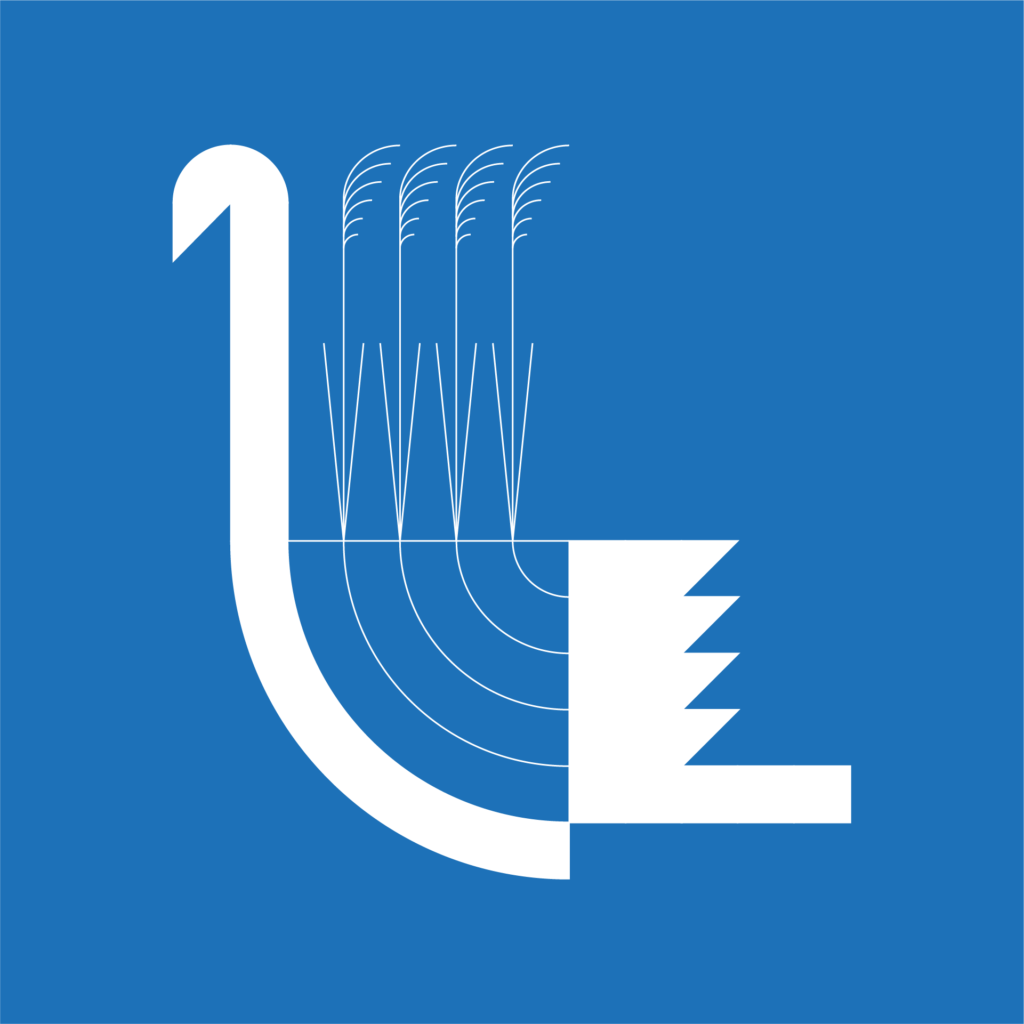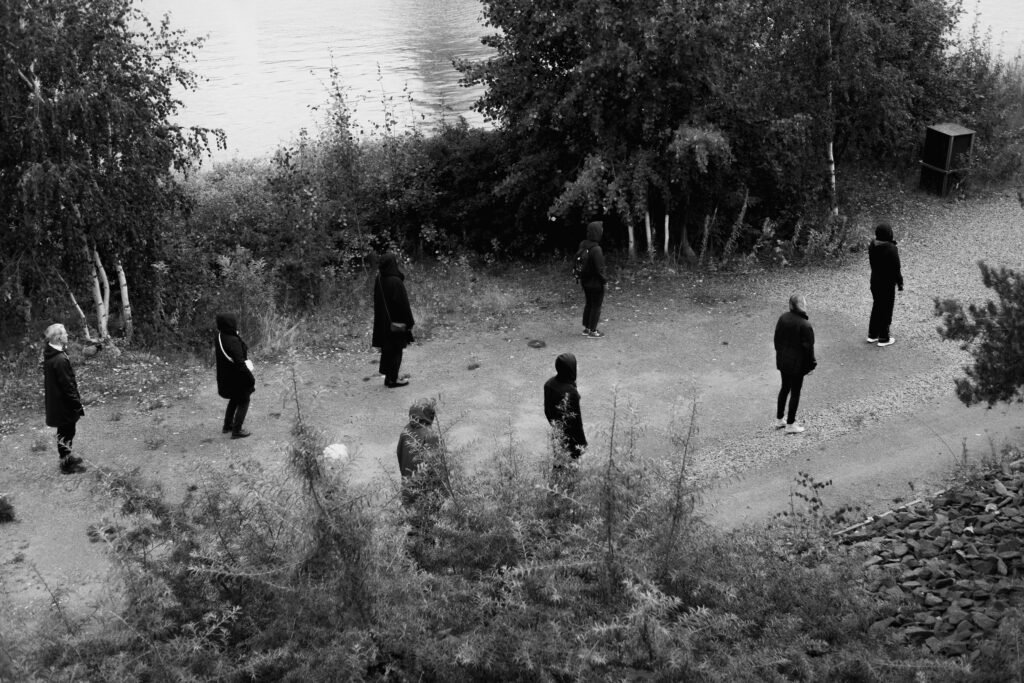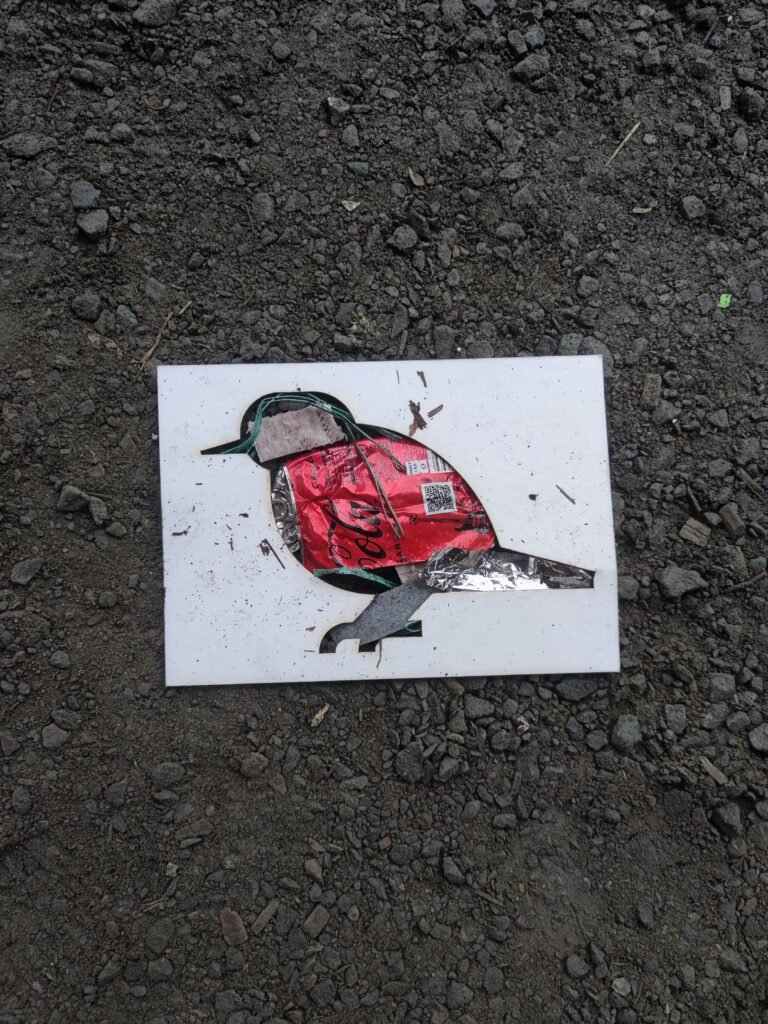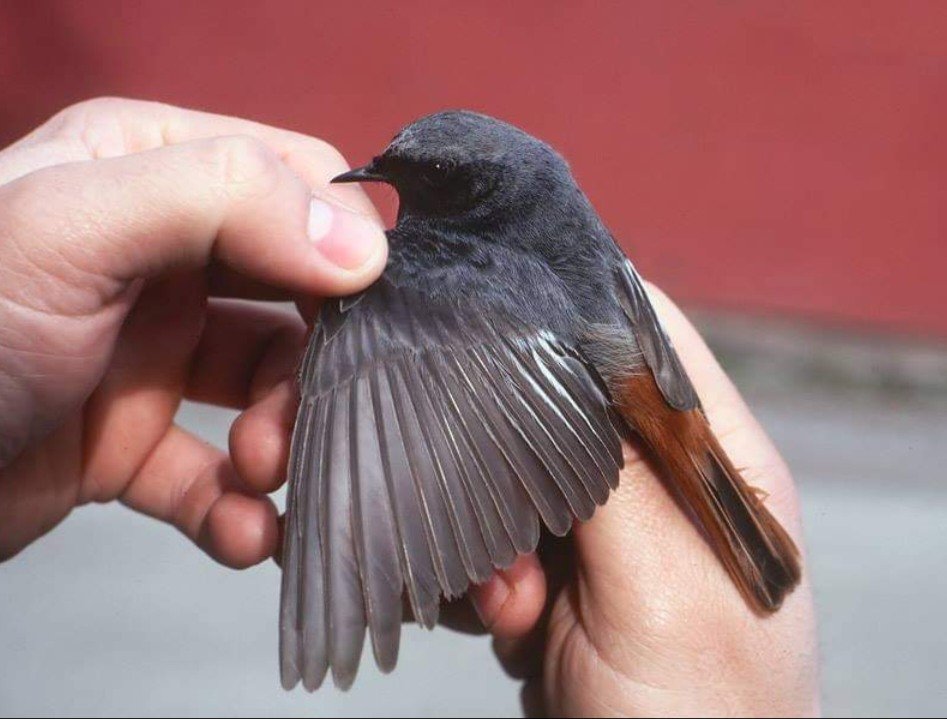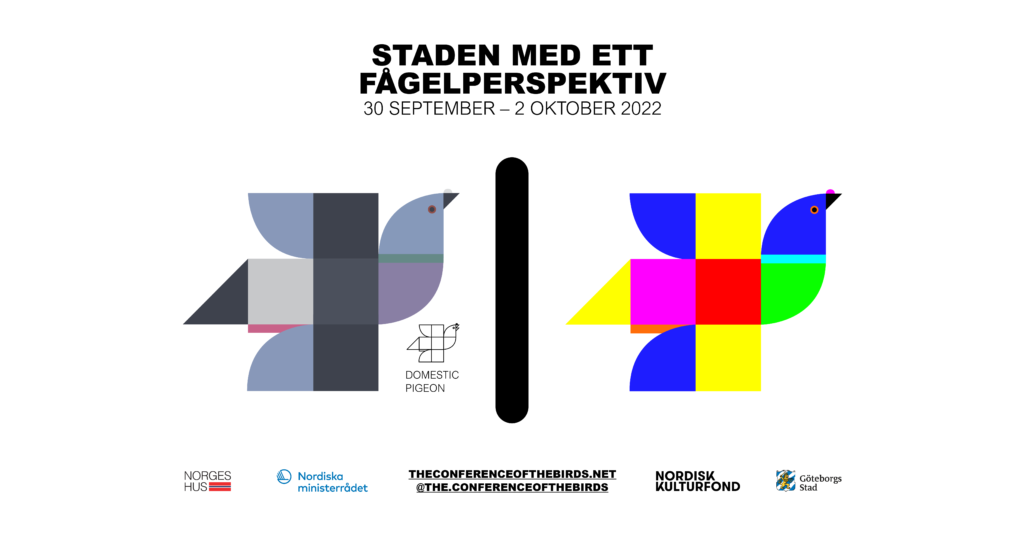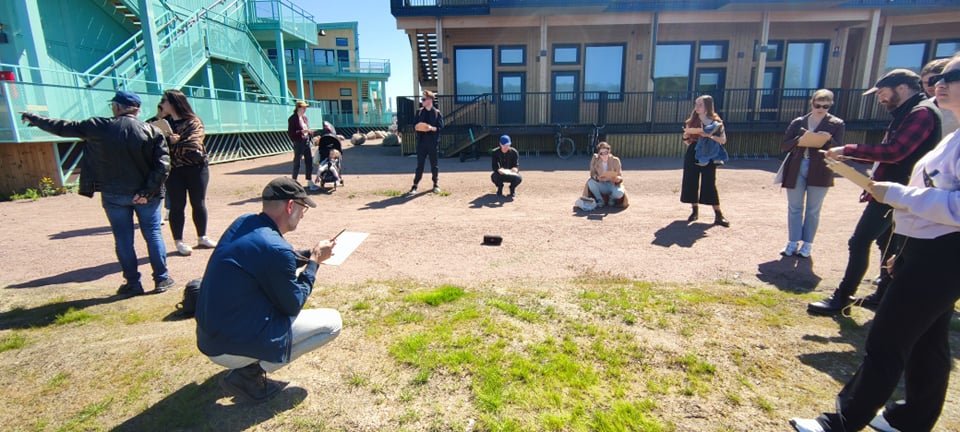Sweden Nest: Frihamnen – Negotiating land use in between birds and human
The Swedish Nest in Frihamnen harbour in Gothenburg is about the negotiation of land use between birds and humans in the city. During public events in 2021-2023, artists, designers, ornithologists, and the public explored the site from a bird’s perspective. The project aimed to deepen the understanding of the more-than-human entanglement in the location by merging historical insights with participants’ artistic, emotional, and physical experiences.
The project focused on Frihamnen, a part of Gothenburg’s harbour that has developed from former bird-rich reed beds, to industrial environments and future residential areas. A diverse group of participants and professionals engaged in interventions, workshops, and artworks on and with the site during public events 2021-2023, curated by artist Ulrika Jansson. The emphasis was on seeing the site from the perspective of birds in the past, present and future and, through various physical and sensory experiences, gaining a deeper emotional understanding of the complex multi-species relationships that exist in a city.
Several artists and designers became part of the project, progressively deepening their engagement. These public gatherings served as experimental spaces to develop artworks and methodologies over time. The goal was to create a comprehensive understanding of the location, intertwining historical insights from site investigations and information from experts, with the artistic, emotional, and physical experiences of the participants. A key element of these public art activities was to create an open, interdisciplinary temporary space where people could meet, connect with the environment, and creatively explore and discuss various urban planning possibilities. At every event, various activities were mixed to give participants the opportunity to navigate from more factual and practical aspects of the site to explore their own emotional and creative responses to the environment. The public events have also functioned as a prototype and an artist in residence period for creating the installation and sound work Varelse / Værelse by Ulrika Jansson, with a point of departure in the teeming birdlife in the historical city reeds.
The Nest in Frihamnen is curated by Ulrika Jansson
Connecting with the more-than-human history of Frihamnen
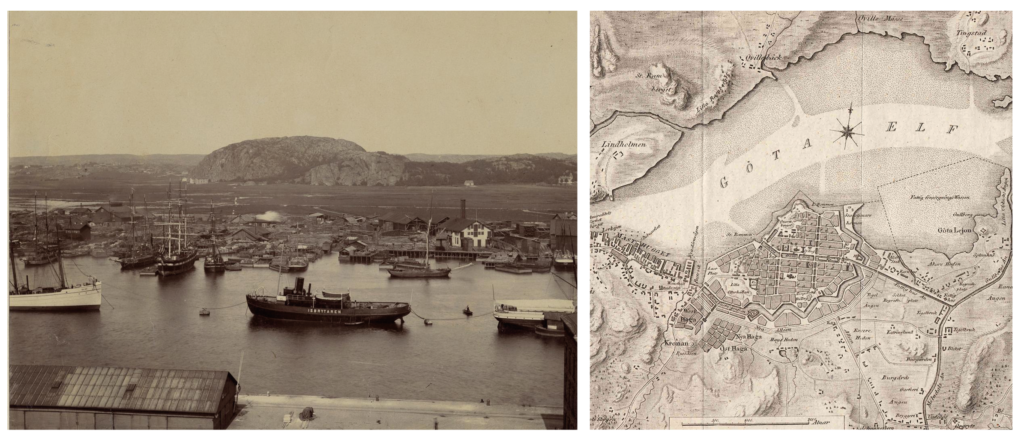
Image: Photograph of Lundbyvass (Lundby reeds) in 1890 when most of the city's water bodies had disappeared, but it is still possible to see the large marshlands that extended between the riverbank and Ramberget on Hisingen. Source: Gothenburg City Museum. Right: On this cropped map of Gothenburg from 1815, the grey water areas represent the reed marshes, larger than the old city centre of Gothenburg within the moat. Source: Map of Gothenburg, A. Lindgren.
The Nest activities focused on the avian-human history of Frihamnen, showcasing the impact of human activity in the transformation from a natural environment to an industrial harbour. In the 19th century, reed marshes along Göta älv had an abundant birdlife, known as one of Northern Europe richest bird areas. By the dawn of the 20th century, most of the the bays had been drained and filled to create space for factories, lumber yards, and docks. The once vibrant wetland chorus of the city reeds, that could be heard from the harbor in to the city centre, had almost disappeared.

Image: Left: The harbour railway. Source: Gothenburg City Museum. Middle: The black redstart. Photo: Reino Andersson. Right: The harbour railway, covered in weedy areas. Source: Gothenburg City Museum.
Many bird species vanished due to the infilling of reed marshes, though some, like the black redstart (Phoenicurus ochruros), thrived. In the early 1980s, ornithologist Reino Andersson studied these birds at Frihamnen, noted that they had adapted to the harbor’s industrial ruins, quite reminiscent of their mountainous European origins. However, Andersson found that the black redstarts relied on large weedy vegetation areas to provide them with insect food. The decline in their numbers after the 1980s was linked to harbor modernization, which replaced these weedy areas with tarmac and demolished old structures for new housing areas.
Looking to the human-avian future
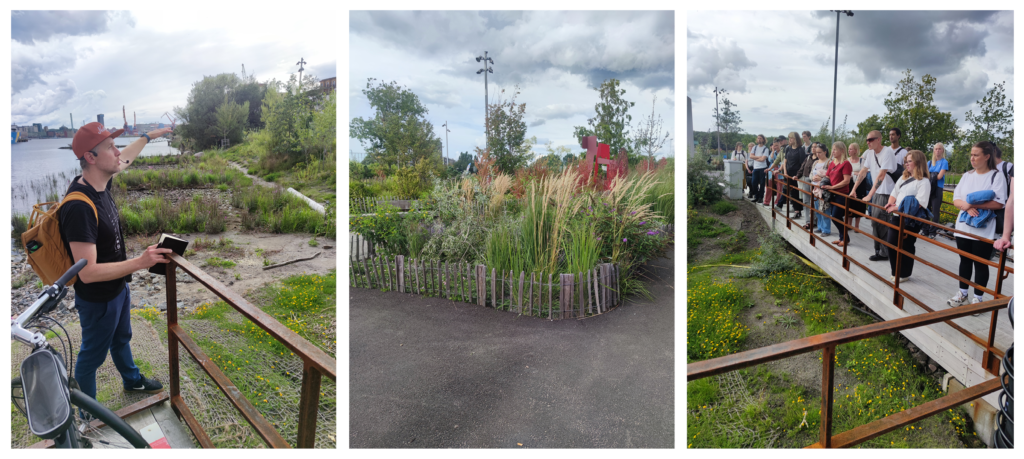
Image: Martin Allik MARELD landscape architects guiding in Jubileumsparken, as part of the Frihamnen Nest, 2023. Photo Ulrika Jansson.
The public art activities in the Nest in Frihamnen were aligned with Frihamnen’s urban transformation, especially through the development of Jubileumsparken by MARELD landscape architects for Gothenburg’s 400th anniversary. When Frihamnen now transforms to a residential area, the newly built Jubileumsparken is an inspiring example of how its urban development can make space for habitat preservation. The park enhance urban green spaces and focus on the area’s existing wild vegetation. Prototyping and testing during the park’s development engaged the public, maintenance staff, and experts, creating a dialogue on urban ecosystems and wildscapes. Throughout the art project, there was ongoing dialogue and collaboration with officials from Göteborg stad and MARELD landscape architects, whose focus on prototyping was incorporated into the project’s approach.

Image: Left: The Council of All Beings workshop. Photo Jansson. Middle and right: Panel discussion with Jonas Uvdal, Olof Olterman and the organisers of the workshop. Photo Ulrika Jansson.
The project engaged professionals, such as landscape architects and city planners, with an awareness of Frihamnen’s ecological past and how it can influence future decisions. They were encouraged to participate in the art activities and interdisciplinary dialogue on development for both humans and more-than-humans. The 2023 communal ritual “The Council of All Beings” by Joanna Macy, adapted by poet Kennet Öhlund and Thomas Laurien, PhD in design from HDK/Valand involved a participatory design exercise letting the participants speak for other species’ needs for the site’s future. A panel discussion with landscape architect Olof Olterman, Jonas Ulvdal from Gothenburg’s City Planning Department, discussed how these perspectives could be integrated into professional practice. Challenges mentioned by Uvdal included high urban development costs and maintaining green and blue values when political priorities tend to shift during a project. Olterman highlighted the value of small-scale experiments with urban habitats and wildscapes to serve as positive functional examples.
Bodily engagement with birds and materials in Frihamnen

Image: “Bring Back Birds” workshop, Christoph Matt. Left and middle: Photo Christoph Matt. Right: Photo Ulrika Jansson
In the “Bring Birds Back” workshop 2022, Austrian eco-social designer Christoph Matt engaged participants with three bird species linked to the past, present and future of Frihamnen. Through a design walk and the use of communication materials, the workshop aimed to bring back birds that disappeared from the area to people’s consciousness combining educational discussions with the creation of bird art using a stencil tool and bodily engagement finding materials from the site connected to the habitats of the birds. As well as sharing insights of how the design of Jubileumsparken provides habitats for birds, the site-specific workshop engaged bodily with its vegetation and organic and non-organic materials. In this activity, participants took on the role of birds searching for nest-building materials unique to each species. By creating artworks from these materials, participants—including the general public, architects, and designers—explored the local environment and expressed a blend of human and bird consciousness through their creations. During the walk educational discussions were combined with the creation of bird art using a stencil template and bodily engagement finding materials from the site connected to the habitats of the birds in the past, present and future.
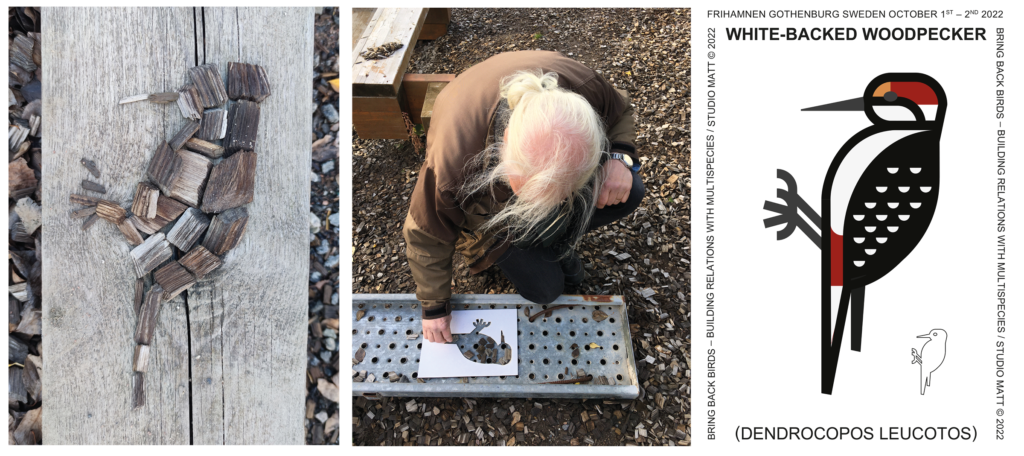
Image: “Bring Back Birds” workshop, Christoph Matt. Left: Photo Ulrika Jansson. Middle: Photo Christoph Matt. Right: Action card with information about the white-backed woodpecker, design Christoph Matt.
For the past, the focus was on the ruff (Calidris pugnax), once native to Frihamnen’s reed marshes. Participants learned about the ruff’s needs and created ruff sculptures from reeds, reflecting on how to adapt the environment to welcome them back. The present was represented by the common and black redstarts, birds that adapt well to industrial and wasteland settings. Using Frihamnen’s waste materials, participants crafted redstart sculptures, highlighting the birds’ nesting habits. Looking to the future, the workshop explored the endangered white-backed woodpecker (Dendrocopos leucotos), underscoring the long-term effort needed to restore its habitat. Participants made woodchip sculptures to symbolize the bird’s dependence on dead wood, particularly aspens, which are being reintroduced to theJubileumsparken but will take years to mature.
Christoph Matt’s contribution to the Conference of the Birds project consist of several place-specific design walks and workshops such as B.I.R.D.S in 2021 and Bird-Human Space in 2023 in Frihamnen as well as Neighbirdhood as part of the public program at Österängen konsthall 2024. Christoph Matt also produced the communication design for the public events in Frihamnen.
Meeting the inner Spirit Bird
In the performance “Andefågeln – Becoming Spirit Bird” 2022 by artist Pernilla Ljungkvist, participants, mimicking a bird flock’s V-formation, listened to a sound piece via headphones while rhythmically swaying with closed eyes. Inspired by research showing that birds in formation of 25 fly more efficiently with lower heart rates, attendees experimented with achieving a similar collective harmony. The experience evolved into an immersive exercise where participants sought to transcend their physical selves and embody their “inner spirit bird.”

Image: Performance Andefågeln - Becoming Spirit Bird. Photo: Stefan Kraupner.
During her research for the performance, Ljungkvist encountered a misunderstanding in an article by ornithologist Reino Andersson (2006) about the city reeds. Initially captivated by the term “andefågeln” (spirit bird), she realised it was a misreading of “andfågeln” (duck bird), a term for certain waterfowl and one of the oldest bird species, which lost their habitat in Frihamnen when the reeds were filled. This sparked the idea of exploring the concept of a personal “Spirit Bird” within individuals, an essence often obscured by modern life’s demands. The performance invited participants to rediscover this essence through three stages: detaching from their human form, undergoing transformation, and connecting with the collective energy of a flock. With their eyes closed, participants visualised themselves entering the space in their newly assumed bird forms, forging a deeply personal emotional connection with a chosen imaginary bird and its habitat. Afterward, by sharing their experiences with the group, participants gained insight into each other’s inner spirit birds and the diverse, more-than-human perspectives of the place.

Image: Left: Leif Lithander, zoologist. Photo Stefan Kraupner. Right: Pernilla Ljungkvist and Anita Campbell. Photo Ulrika Jansson
Post-performance, while reflecting on their experiences, the participants were also provided with more factual insights in a conversation about birds with Pernilla Ljungkvist together with Anita Campbell, a neurochemistry docent, and Leif Lithander, a zoologist. Campbell discussed birds’ cognitive functions and their implications for understanding human diseases, while Lithander connected urban avian history to the city’s landscape, enriching the participants’ understanding of birds’ significance both environmentally and symbolically.
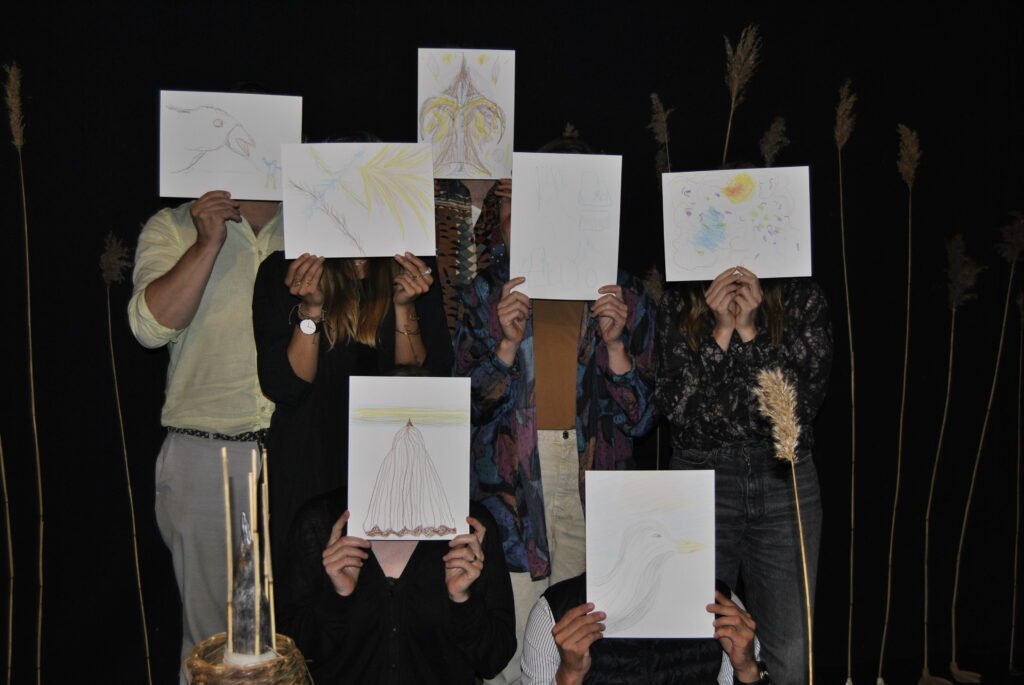
Image: Spirit Bird - Revival, participatory performance, Pernilla Ljungkvist. Photo: Pernilla Ljungkvist
In Spirit Bird – Revival, performed at Skogen performing arts platform 2023, Pernilla Ljungkvist deepend her work creating a movement-based performance and a sound piece that delves deep into one’s own experience of being a bird, with an attempt to capture that experience in a drawing in the end. What would happen if you let go of your human body and instead allowed yourself to transform into a bird – your inner Spirit Bird – is it even possible? You will be taken on an external and internal journey through the body, in a mixture of movement and stillness. The transformation occurs as a group, like a flock of birds meeting in the sky, but the participation is individual, and a significant portion of the performance is conducted with closed eyes.
Varelse – Værelse – the inseparable bond between creatures and their habitats
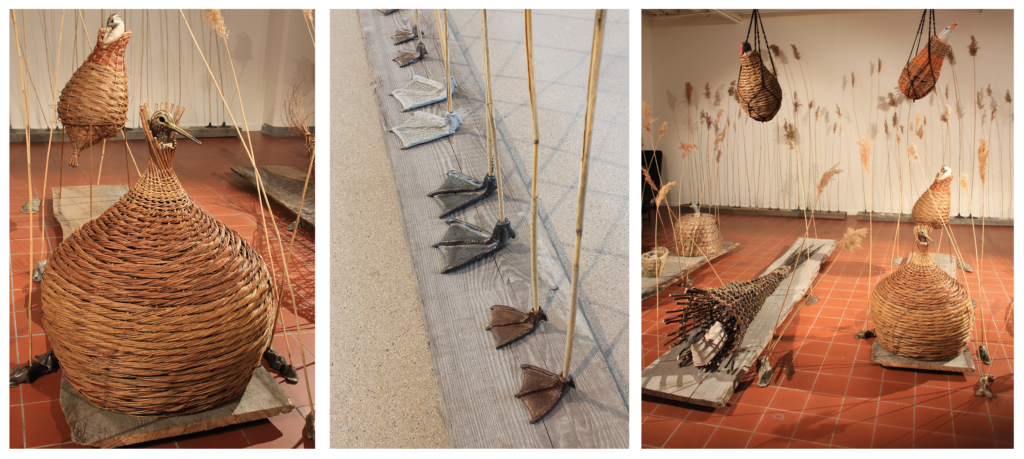
Image: Varelse-Værelse by Ulrika Jansson in the exhibition The Conference of the Birds in Österängen konsthall, Jönköping 2024. Photo Ulrika Jansson
The installation Varelse – Værelse*, developed by artist Ulrika Jansson parallell with the public art activities 2021-2023, evoked Frihamnen’s lost reeds and birdlife, emphasising the bond between creatures and their habitats. This experience was designed to complement the physical engagement with Frihamnen through activities and discussions by offering a reflective, inner experience at the nearby Skogen performing arts platform. The work’s title, blending the Danish “værelse” (room) with the Swedish “varelse” (being) – both sharing a common linguistic root – reflects the inseparable bond between creatures and their habitats, emphasising the loss of one with the disappearance of the other.
Jansson explored the site’s intertwined history of vegetation and birds by crafting sculptures from local materials like reeds, grass, and clay, including hand woven traditional basket forms merging with ceramic bird figures. Participants, lying in a darkened room amidst the installation, experienced a sound-guided visualization using hypnosis to heighten sensory awareness and connect participants with the memories of the ancient reed marshes. This immersive experience aimed to broaden understanding and empathy by aligning the participants’ inner landscapes with the place’s spirit.
* The title Varelse – Værelse is borrowed from the text “Rördrommens rum” by Kennet Öhlund
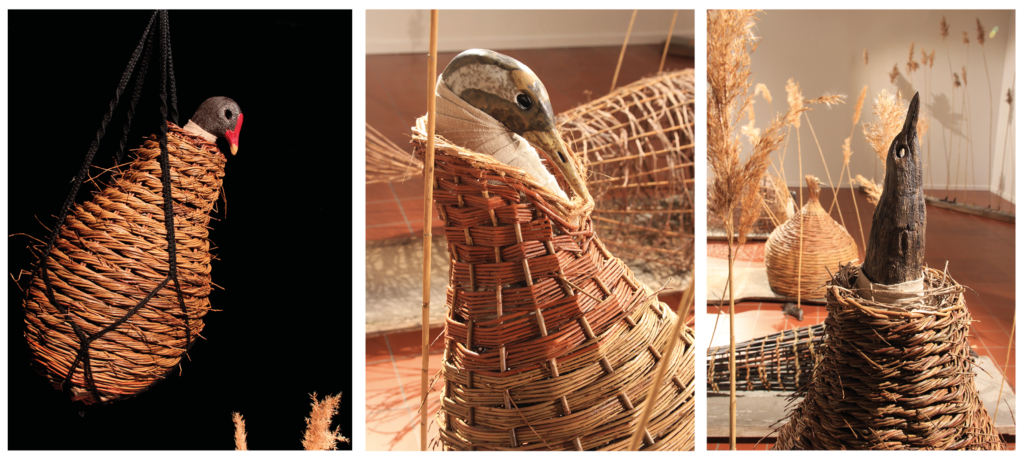
Image: Varelse-Værelse by Ulrika Jansson in the exhibition The Conference of the Birds in Österängen konsthall, Jönköping 2024. Photo Ulrika Jansson
Jansson experimented with local materials crafting sculptures, including traditional basket forms merging with ceramic bird figures. These included recreated traditional fishing tools like baskets, eel pots, and fish traps, all handwoven from plant fibres local to the area such as reeds, grass, and willow, with supervision from Danish basket maker Steen H. Madsen specialised in historical basketmaking. The site-specific clay was moulded into ceramic heads and feet of bird species that once inhabited the area. The sculptures presented in the installation aimed to preserve the essence of the place, evoking a dream-like impression of the river’s history. In the meeting of river and sea, of sweet and salty, of land and water, is a gateway to another world – a passage, a transition from one state to another. While scientific knowledge is valuable, this immersive experience offered understanding through sensations, intuition, and feelings. It aimed to shift participants’ consciousness, revealing life’s interconnectedness and human impact on the environment.
Varelse – Værelse in exhibitions:
- The Conference of the Birds major exhibition at Österängens konsthall, Jönköping in 2024.
- Undergrowth, Konsthallen Trollhättan 2023
- Skogen performing arts platform, Göteborg, 2023
The video Staden med ett fågelperspektiv
Staden med ett fågelperspektiv
(The city with a bird’s eye view, Swedish and English speech)
Ulrika Jansson, Kristina Meiton, 2023
Video, 19 min
The city with a bird’s eye view is a documentation video of one of the public events organised by artist Ulrika Jansson in Frihamnen 2021-2023. Through conversations and participatory workshops, invited artists, specialists and the public explored what coexistence between species can mean in urban planning. The emphasis was on seeing the site from the perspective of birds in the past, present and future and, through various physical and sensory experiences, gaining a deeper emotional understanding of the complex multi-species relationships that exist in a city.
Participants in the Swedish Nest in Frihamnen:

Ulrika Jansson (SE)
Artist/Curator
Ulrika Jansson’s artistic practice navigates the confluence of place, human interaction, and ecology. She engages in interdisciplinary projects that bring global ecological issues into a local context processed through artistic methods. Her diverse works, showcased in multi-part audiovisual installations, blend sculpture, stop-motion film, and sound techniques. These pieces often incorporate handicraft techniques, plant materials and natural phenomena, enhancing engagement with the more-than-human world.
www.ulrikajansson.com
@ulrika.jansson_

Pernilla Ljungkvist (SE)
ArtisT
Pernilla Ljungkvist’s work is conceptual with performance, text, sound and participatory processes as the main material, along with influences from various mind-expanding practices butoh, meditation and yoga. Her artistic practice moves in the borderland between social experiments, pseudo science and often examines existential issues based on personal stories.
www.pernillaljungkvist.se
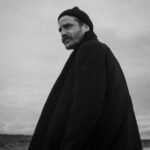
Christoph Matt (AU)
COMMMUNICATION DESIGNER
Christoph Matt is an Austrian eco-social designer and founder of the internationally awarded Studio Matt. A nomadic studio for sustainable design with a focus on the living environment and social issues, currently based in Vienna. The projects and works are always dedicated to the interplay of planet earth, the human and more-than-human.

Black redstart
(Phoenicurus ochruros)
BIRD
The black redstart is a small passerine bird and we found the postwar ruins in European cities reminiscent of our mountainous European origins. But this meant that our expanded territories were often ephemeral. Gentrification and redevelopment is our enemy. There has been a notable decline in our population which is likely linked to gradual disappearance af abandoned ruderat weedy areas and wrecked buildings.

Ruff
(Calidris pugnax)
BIRD
The ruff is a migratory wading bird that breeds in marshes and wet meadows across northern Eurasia. Large flocks are formed at the stopover site for feeding. We are known for getting our main energy source from lipids for migrating and exercise, unlike mammals. We keep ourselves warm by shivering. and we have notable courtship behavior and spectacular plumage! Our population has more than halfed in some countries in Europe due to drainage, increased fertiliser use, the loss of formerly mown or grazed breeding sites and over-hunting.

White-backed woodpecker
(Dendrocopos leucotos)
BIRD
The white-backed woodpecker feed on wood-boring and bark-living insects, living in dead and decaying wood. Our species is critically endangered in Sweden. Today there are only 60 individuals left, but 250 individuals are needed for our survival. Unfortunately, the forest industry in Sweden has replaced deciduous trees with pine and spruce which are more profitable. This had led to an impoverishment of our habitat.

